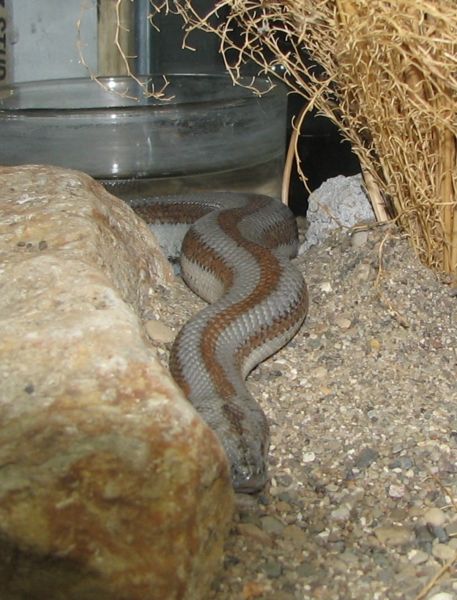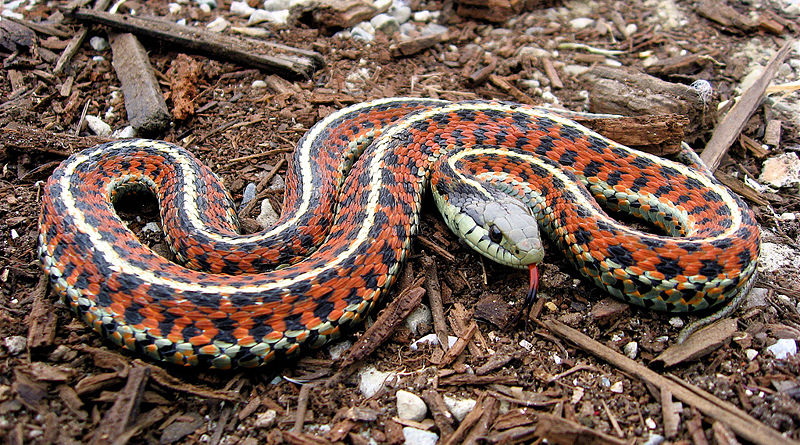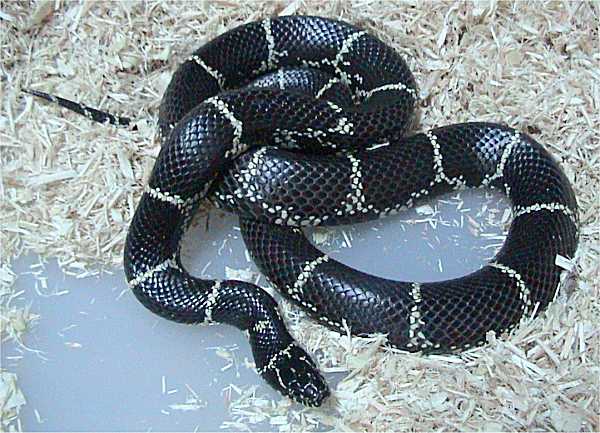 Snake enthusiasts are faced with an embarrassment of riches these days…with so many interesting and formerly rare species being bred, choosing a pet can be very difficult. Today I’d like to spotlight several species that are hardy enough for beginners yet so interesting that they are also favored by specialists and zoos – the Garter, Rat and King Snakes and the Rosy Boa and Ball Python. Please see the articles linked below or write in for detailed husbandry information.
Snake enthusiasts are faced with an embarrassment of riches these days…with so many interesting and formerly rare species being bred, choosing a pet can be very difficult. Today I’d like to spotlight several species that are hardy enough for beginners yet so interesting that they are also favored by specialists and zoos – the Garter, Rat and King Snakes and the Rosy Boa and Ball Python. Please see the articles linked below or write in for detailed husbandry information.
Rosy Boa, Lichanura trivirgata
Common and Red-Tailed Boa Constrictors are among the world’s most popular snakes, but their large size makes them impractical in many collections. The beautiful Rosy Boa, which tops out at a bit over 3 feet long, is a far better choice for most folks.
Many people do not realize that 2 boas are found in the USA, the Rosy and the Rubber Boa (more on this interesting little fellow in the future). Ranging from southern California and southwestern Arizona through Sonora, Mexico, the Rosy Boa is something of a “big snake in a small package”, and provides a great introduction to constrictor-keeping.
Calm in demeanor, it is a good choice for those who want a handle able snake. A wide variety of captive-bred color strains are available, and those wishing to breed snakes will be pleasantly surprised at how cooperative the Rosy Boa can be. They are live bearers, so breeders are spared the trouble of incubating eggs, and the 3-6 young typically produced are large enough to accept pink mice.
Garter Snakes, Thamnophis spp.
 Over 30 species of these attractive, interesting snakes may be found in North America. Garter Snakes are ideal for those who enjoy setting up planted, naturalistic terrariums, where they will readily display all of their normal behaviors and even breed. Their young are born alive, and are easy to rear.
Over 30 species of these attractive, interesting snakes may be found in North America. Garter Snakes are ideal for those who enjoy setting up planted, naturalistic terrariums, where they will readily display all of their normal behaviors and even breed. Their young are born alive, and are easy to rear.
Unlike many snakes, Garters are quite active and have high metabolisms – ideal for those who enjoy feeding their charges. They do well on small fishes and earthworms – a bonus for people who prefer not to use rodents as food.
The San Francisco Garter Snake is one of the scarcest and most colorful of all snakes; others, such as the Butler’s, Eastern and Aquatic Garter Snakes, are often bred by hobbyists. Please see the article below for more on these and other species.
American Ratsnakes and Corn Snakes, Pantherophis obsoleta, P. guttata
These snakes are pet trade staples, and with good reason. Hardy and easy to breed, Ratsnakes are large enough to satisfy those who want a snake of substantial size, yet small enough to be housed comfortably in a 30-55 gallon terrarium (unusually large specimens may exceed 6 feet, but most average 3-4 feet long). Captives have exceeded 30 years of age.
 Ratsnake taxonomy has been revised recently, with several former species being eliminated. However, hobbyists tend to retain the older common names – Black, Texas, Gray, Everglades and Yellow Ratsnakes are among the most popular species/races, and a variety of color phases and hybrids have been produced (the Corn Snake, sometimes known as the Red Ratsnake, is available in at least 25 distinct color phases).
Ratsnake taxonomy has been revised recently, with several former species being eliminated. However, hobbyists tend to retain the older common names – Black, Texas, Gray, Everglades and Yellow Ratsnakes are among the most popular species/races, and a variety of color phases and hybrids have been produced (the Corn Snake, sometimes known as the Red Ratsnake, is available in at least 25 distinct color phases).
Ratsnakes can be defensive, but most calm down quickly. They do well at 72-78 F, with a warmer basking site, readily accept mice and small rats, and provide a great introduction to the breeding of egg-laying snakes.
Eastern Kingsnake, Lampropeltis getula
Another snake enthusiast’s favorite, the 7 subspecies of the Eastern Kingsnake are all well-suited to captivity. Related species, including the California, Desert and Florida Kingsnake, are also well-established in private collections. Most top out at 3-4 feet in length, with rare individuals reaching 6.5 feet.
 Kingsnakes are known for the unusually wide range of prey they take –venomous snakes (please see video below), lizards, rodents, frogs, turtle eggs, insects and birds are all on the menu. Captives are rarely particular, however, and fare well on mice.
Kingsnakes are known for the unusually wide range of prey they take –venomous snakes (please see video below), lizards, rodents, frogs, turtle eggs, insects and birds are all on the menu. Captives are rarely particular, however, and fare well on mice.
Kingsnakes are quite hardy and breed readily, but cannot tolerate damp conditions. Cannibalism is a definite concern as well, and some individuals persist in trying to swallow one’s fingers – not an aggressive response, just a “sampling” of a new food, perhaps. Care in handling is therefore essential.
Ball or Royal Python, Python regius
This popular, stoutly-built snake gives the appearance of being much larger than its usual 4 foot length (rarely, odd specimens may reach 6 or even 7 feet). Ball Pythons are not very active, and an ideal choice for those who desire a large snake, but lack space.
 Although generally mild in temperament, Ball Pythons can bite when threatened, and so must be handled carefully. Wild caught specimens can be extremely choosy concerning their food, but most these days are captive bred and accept mice and rats. Prolonged fasts are common, and may upset new owners – please see the article below for further information. Albino, pastel and a variety of other color phases are available, but the wild form is also quite spectacular.
Although generally mild in temperament, Ball Pythons can bite when threatened, and so must be handled carefully. Wild caught specimens can be extremely choosy concerning their food, but most these days are captive bred and accept mice and rats. Prolonged fasts are common, and may upset new owners – please see the article below for further information. Albino, pastel and a variety of other color phases are available, but the wild form is also quite spectacular.
Further Reading
Video: Wild California Kingsnake consuming a Rattlesnake
Please see the following article for detailed information on care and breeding:
Rosy Boa
Garter Snakes
Rat Snakes
Ball Pythons
Coast Garter Snake image referenced from wikipedia and originally posted by Steve Jurvetson
Eastern King Snake image referenced from wikipedia and originally posted by Dawson
 That Reptile Blog – Reptile, Amphibian and Exotic Pet Care and Information
That Reptile Blog – Reptile, Amphibian and Exotic Pet Care and Information



I have been thinking about getting a snake. However I have not yet decided weather or not i would enjoy having one, because i am slightly afraid of being bitten. When getting a snake should assume you will probably get bitten at some point in time at least once?
Hello Alistar,
Thanks for your interest and for raising this very important point. No need at all to assume you’ll be bitten. Unfortunately, on some website people seem to regard bites as a “badge of honor”, and this misleads those who are interested in learning. I’ve handled many thousands of venomous and non-venomous snakes during my years working at zoos, and have only been bitten during field research, where it was difficult to control conditions (i.e. in water, working with others, trying to subdue large anacondas).
Bites from non-venomous snakes can cause serious infections, and so should never be treated lightly.
I can give you some handling tips when you are ready; also there are snake hooks and other handling tools that are useful. Several species rarely bite and make great pets…DeKay or Brown Snakes, for example.
Please let me know if you need any further information. Good luck, enjoy and please keep me posted.
Best regards, Frank Indiviglio.
Thank you very much for the helpful information. I believe i have narrowed down my choices to the Carpet Python or a Ball Python. I believe i have quite a bit more research to do on this two snakes to decide what one i want as my start into snakes. Once quick question i have been having trouble finding the answer to is with the different mutations within the snake does it make it have different characteristics or attitudes or just change in color? Also what exactly is the difference between a Ball Python and a Fancy Ball Python?
Hello Alistair
Thanks for the feedback; nice to see you are looking into this carefully before deciding. This Ball Python article and those linked at the end of it might be of interest.
Carpet pythons are usually quite hardy, but they do get larger than ball pythons and need more room, as they are also more active.
The various colors are just mutations that have been selectively bred by hobbyists; they have nothing to do with behavior and so on. “Fancy” is a general term…some terms are fairly specific, i.e. “Leucistic” or “Albino”, but breeders and stores also make up new ones or change others to suit their needs.
Please let me know if you need any further information. Good luck, enjoy and please keep me posted.
Best regards, Frank Indiviglio.
I recently contacted you from Albany, NY to ask about snakes appropriate for my son to raise. I have a few additional questions:
What is the minimum floor space requirement for an adult corn snake? Do they fare well in a planted terrarium with braches to climb and foliage for hiding?
I love the idea of getting a garter snake; they are small, are found locally, and my son loves to catch them in our yard. I’ve read, though, that they don’t fare as well in captivity. Is there truth to that? Why?
Do you know of any reputable, relatively local, source for obtaining captive-bred snakes? I’m located near Albany, but have family in the Poconos.
We won’t be purchasing the snake soon. We’ve worked out an arrangement for our son to demonstrate that he can take care of a pet, but I want to make sure that we’ve done all of our research ahead of time.
Thanks again,
Kari
Hello Kari
Thanks for your interest and for posting here.
Most adults will need a 30-55 gallon aquarium (a 55 measures 4 feet long, about half as wide). Commercial cages are also available. Hatchlings can be kept in a 10 gallon aquarium for a year or 2. Here is an article on Corn Snakes, as well as Black Ratsnake care, which applies to them as well.
Corn do fine in planted terrariums; it takes some planning for adults, re plant species, anchoring branches, but is well worth the effort. I’ve designed many zoo exhibits for them and can help out when you are ready. Please see this article on Naturalistic Snake Terrariums.
Garter snakes are ideally suited to planted terrariums, and even wild caught ones usually do quite well. The have shorter life-spans than Ratsnakes and others, 8-10 years or so, and do not always take well to handling. But very interesting, active and have higher metabolisms than most snakes; often forage for food, and eat more frequently. Allowing earthworms and beetle grubs to establish themselves in the tank allows for great observations, learning potential – locating hidden prey via scent, etc. Here is a four part article on their care and nat. history.
I don’t have any direct contacts there, but check http://www.kingsnake.com , under classifieds, corn snakes (the more expensive animals will be unique color phases. See the events section also, for nearby reptile expos…should be several in your area in the spring, great way to buy from private breeders, and the least expensive option.
Please let me know if you need any further information. Good luck, enjoy and please keep me posted.
Best regards, Frank Indiviglio.
Thanks for all your informative posts. They’re really very good!
I have a ball python and I love it to bits! As you’ve expressed on other parts of this site, the only problem seems to be when they go on hunger strikes. But that’s a small price to pay for such a good pet, I think.
Really enjoying this blog, and keep up the good work!
Hi Elise,
Thanks for your interest and kind words; here’s an article on their natural history, which should be helpful in explaining their captive behavior and needs. The link to Part II is at end of article,
Enjoy, Best., Frank
Great article! Been very happy with my two leopard geckos, but would like to expand my reptile collection to include a snake. Unfortunately my boyfriend is VERY against having one 🙁
Gonna work on changing his attitude; looking most seriously at a Kenyan sand boa, ball python, or a cornsnake. The bad thing about a sand boa is (I’m assuming) it’s not a snake that’ll wrap around your arm or something. That’s one of the reasons I’d like a ball python…
Hi Paul,
Thanks for the kind words, much appreciated. Yes, Sand Boas do not take well to handling, and spend most of their time buried in the substrate. Corn Snakes and ball Pythons are usually mild mannered, but all snakes must be handled with care. Ball pythons routinely go on long fasts, which tends to worry new owners.
You might enjoy these articles on Corn Snake Care and Ball Python Care. Please let me know if you have any questions.
A happy and healthy new year to you and yours, Frank
I have a ball python and found a baby garter snake. Is it okay to keep them in the same tank? Will the garter snake give my ball python any diseases?
Hi Samantha,
It’s not a good idea to keep snakes from different parts of the world together..parasites and micro-organisms carried by one, which may cause no problems as long as the animal is in good condition, can be fatal to another. A wild-caught garter snake in particular would be a concern,. as all such animals will be host to some parasites.Also, the needs of the 2 species, in terms of terrarium set-up, heat, humidity, diet, etc., are very different. This 4 part Article covers garter snakes and their care. Please let me know if you have further questions, Best, Frank